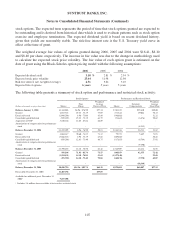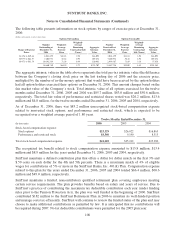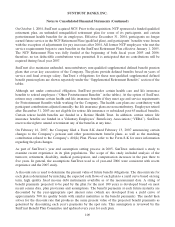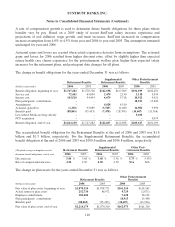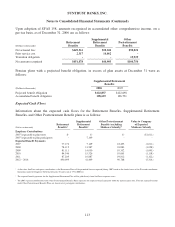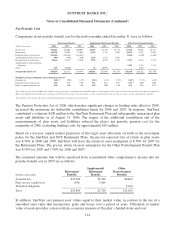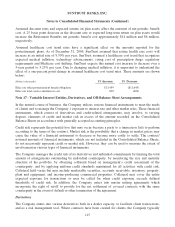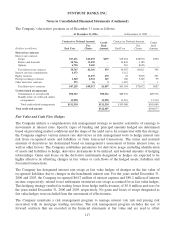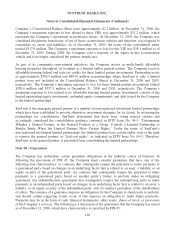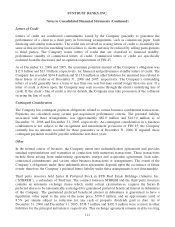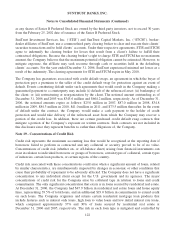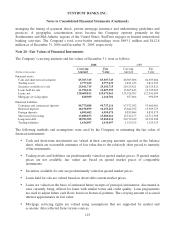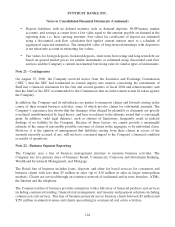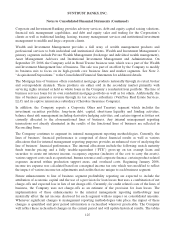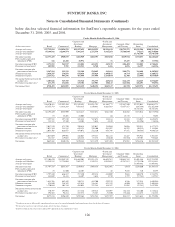SunTrust 2006 Annual Report Download - page 129
Download and view the complete annual report
Please find page 129 of the 2006 SunTrust annual report below. You can navigate through the pages in the report by either clicking on the pages listed below, or by using the keyword search tool below to find specific information within the annual report.SUNTRUST BANKS, INC.
Notes to Consolidated Financial Statements (Continued)
enters into transactions with dealers to offset its risk exposure. Derivatives entered into in a dealer
capacity and those that either do not qualify for, or for which the Company has elected not to apply,
hedge accounting are accounted for as free standing derivatives. As such, those derivatives are carried at
fair value on the Consolidated Balance Sheet, with changes in fair value recorded in noninterest income.
Derivatives designated in hedging transactions are accounted for in accordance with the provisions of
SFAS No. 133.
The Company’s derivatives are based on underlying risks primarily related to interest rates, equities,
foreign exchange rates or credit, and include swaps, options, and futures and forwards. Swaps are
contracts in which a series of net cash flows, based on a specific notional amount that is related to an
underlying risk, are exchanged over a prescribed period. Options, generally in the form of caps and
floors, are contracts that transfer, modify, or reduce an identified risk in exchange for the payment of a
premium when the contract is issued. Futures and forwards are contracts for the delayed delivery or net
settlement of an underlying, such as a security or interest rate index, in which the seller agrees to deliver
on a specified future date, either a specified instrument at a specified price or yield or the net cash
equivalent of an underlying.
Derivatives expose the Company to credit risk. If the counterparty fails to perform, the credit risk is
equal to the fair value gain of the derivative. The credit exposure for swaps and options is the
replacement cost of contracts that have become favorable to the Company. The credit risk inherent in
futures is the risk that the exchange party may default and, because futures contracts settle in cash daily,
the Company is exposed to minimal credit risk. The credit risk inherent in forwards arises from the
potential inability of counterparties to meet the terms of their contracts. The Company minimizes the
credit or repayment risk in derivative instruments by entering into transactions with high quality
counterparties that are reviewed periodically by the Company’s credit committee. The Company also
maintains a policy of requiring that all derivatives be governed by an International Swaps and
Derivatives Associations Master Agreement; depending on the nature of the derivative transactions,
bilateral collateral agreements may be required as well. When the Company has more than one
outstanding derivative transaction with a single counterparty, and there exists a legally enforceable
master netting agreement with the counterparty, the Company considers its exposure to the counterparty
to be the net market value of all positions with that counterparty if such net value is a liability to the
Company and zero if such net value is an asset to the Company. The net market position with a
particular counterparty represents a reasonable measure of credit risk when there is a legally enforceable
master netting agreement, including a legal right of offset of receivable and payable derivatives between
the Company and a counterparty.
Derivatives also expose the Company to market risk. Market risk is the adverse effect that a change in
interest rates, currency rates or implied volatility has on the value of a derivative. The Company
manages the market risk associated with its derivatives by establishing and monitoring limits on the
types and degree of risk that may be undertaken. The Company continually measures this risk by using a
value-at-risk methodology.
116



